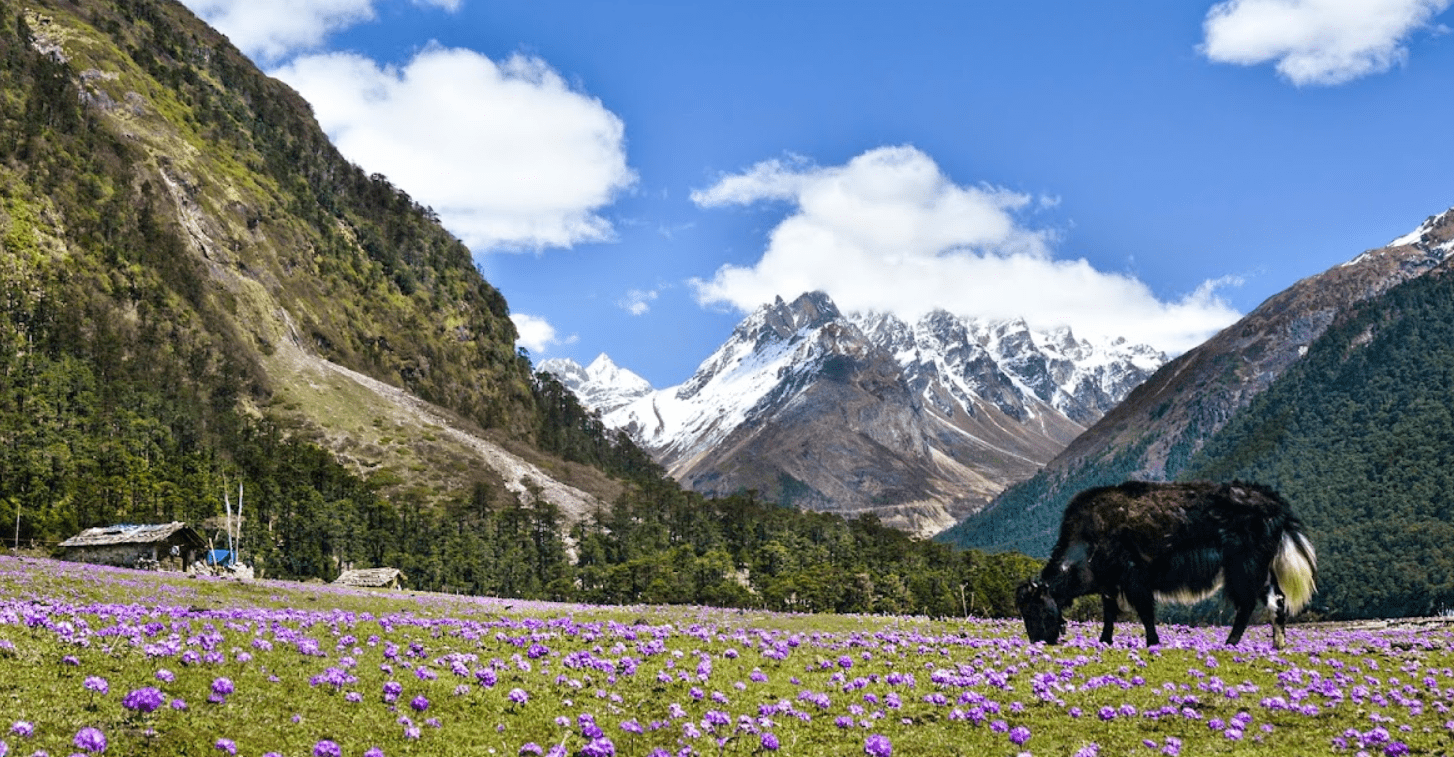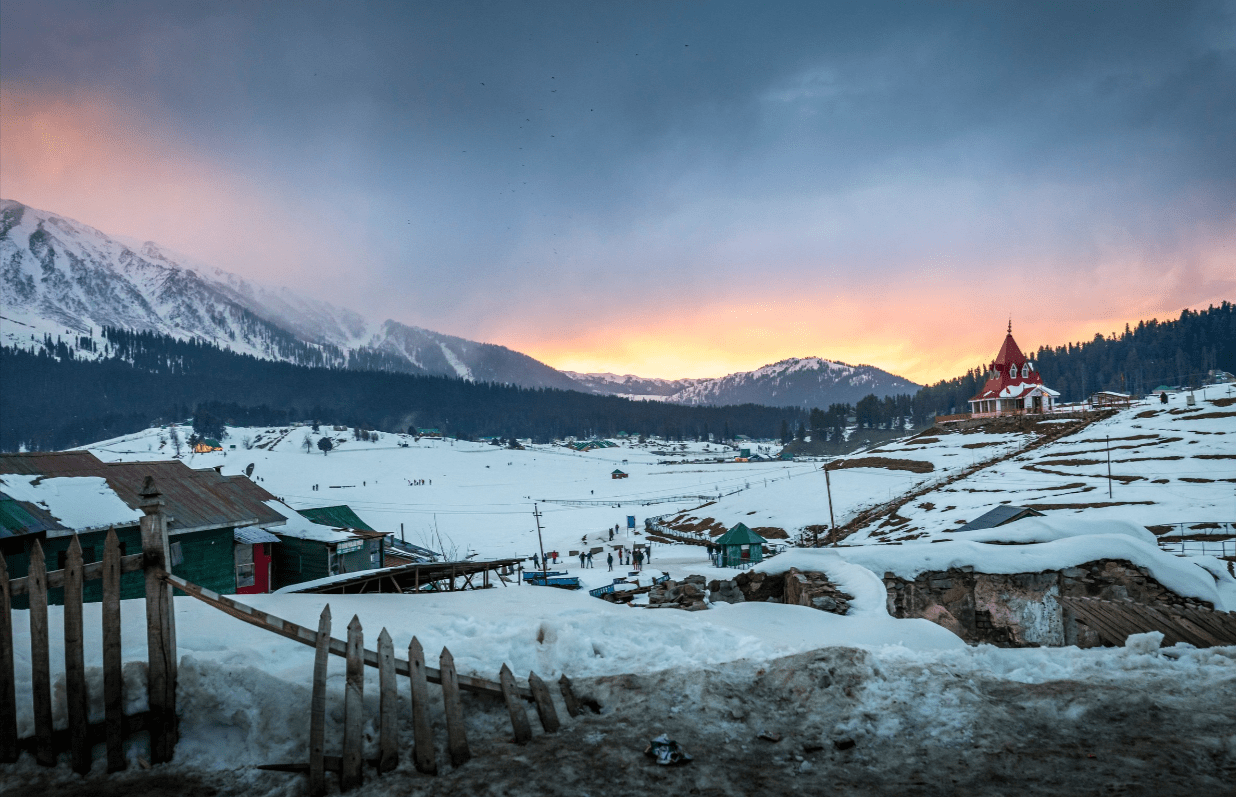If there’s one destination in Sikkim that we would eagerly return to, it’s Yumthang Valley. Often referred to as the Valley of Flowers in Sikkim, Yumthang Valley, along with Lachung, stands out as one of the most picturesque spots in the region. The valley’s charm evolves with each season, offering unique landscapes and breathtaking views year-round. Whether it’s the snow-capped peaks juxtaposed with the flowing rivers or the vibrant bloom of rhododendrons in spring, Yumthang captivates visitors every time. It’s a place so enchanting that falling in love with it seems almost inevitable.
Planning a trip to Sikkim? Here’s everything you need to know for your journey to this beautiful destination.
The allure of Yumthang Valley is so remarkable that Dr. Joseph Hooker, in his 1855 ‘Himalayan Journal,’ described Lachung and Yumthang as two of the most picturesque spots in Sikkim, even likening them to the valleys of Switzerland. While we prefer not to compare places, recognizing each for its own unique beauty, our visit to Yumthang Valley was serendipitous, and I’m excited to share our experience. Typically, a trip to Yumthang Valley and Lachung also includes Lachen and Gurudongmar Lake, and that was indeed our route.
Yumthang Valley in North Sikkim
Location and Accessibility
Yumthang Valley is situated in North Sikkim at approximately 3,500 meters above sea level. It’s about 140 km from Gangtok, the state capital. The journey from Gangtok to Yumthang usually cannot be completed in a single day. Travelers typically overnight in Lachung, a quaint town en route to Yumthang. The following morning, you can visit Yumthang Valley and proceed to Zero Point or Yumesamdong.
Why Visit Yumthang Valley?
There are numerous reasons to visit Yumthang Valley. Here are a few:
- A Dreamlike Destination
At an altitude of 11,800 feet (3,500 meters), Yumthang Valley is encircled by snow-capped peaks like Pauhunri and Shundu Tsenpa, with the Yumthang Chu River flowing through it. This setting creates a stunning visual experience and is a highlight of Sikkim tourism. - The Valley of Flowers
Known as the Valley of Flowers, Yumthang Valley lies at the tree line’s edge, giving it a unique flora. The valley features not only trees and rhododendrons but also a variety of low-growing Himalayan shrubs. In spring, the valley transforms into a vibrant canvas of blooming rhododendrons in colors such as red, yellow, pink, white, purple, and blue. The peak blooming season runs from March to May, and Yumthang Valley houses the Shingba Rhododendron Sanctuary. - Shingba Rhododendron Sanctuary
The Shingba Rhododendron Sanctuary, located within Yumthang Valley, spans an altitude of 3,048 to 4,575 meters. This sanctuary is bordered by the Chuba-Sagochen ranges to the east and the Chomzomei Tso extending to the Lava Pass to the west. Covering 43 square kilometers, it hosts around 38 varieties of rhododendrons. A board at the sanctuary entrance displays images of the different rhododendron types. It surpasses other Sikkim sanctuaries in variety and color. The peak flowering season is from March to May. In addition to rhododendrons, the sanctuary is home to other floral species such as Potentillas, Saxifrages, Primulas, Aconites, Poppies, Primroses, Cinquefoils, and Cobra-lilies. The vibrant flora makes it a paradise for photographers. During the flowering season, you might also spot rare Himalayan birds like the Ibis, Wood Snipe, and Himalayan Monal if you bring a local bird guide. - Yumthang Hot Springs
The Yumthang Hot Springs, with their naturally warm waters, offer a pleasant contrast to the surrounding cold climate. Just before entering Yumthang Valley, a pathway leads to a hanging bridge over the Yumthang Chu River. Crossing the bridge, you’ll find stairs leading to huts where the hot spring water is directed into pools for bathing.
Zero Point or Yumesamdong
Located 23 km beyond Yumthang Valley at an altitude of 15,000 feet, Zero Point (Yumesamdong) is a remote destination where three rivers converge amidst snow-covered mountains. The road to Zero Point is challenging, but the views are incredibly rewarding. Snow covers the area year-round. It takes about 1.5 hours to reach Zero Point from Yumthang Valley, which is also the endpoint of civilian roads. Although the Indo-China border is nearby, civilians cannot travel beyond Zero Point.
Yumesamdong also features a couple of hot springs. The Donki La Pass, connecting Lachen and Lachung at 18,400 feet, is located here, though it is inaccessible. Enjoy the stark mountain views from Zero Point.
Seasonal Beauty of Yumthang Valley
Yumthang Valley showcases different beauties throughout the seasons. In spring, it’s a floral paradise, while winter transforms it into a snow-covered wonderland. The monsoon season brings lush greenery and freshness, with some small Himalayan flowers blooming. Overall, Yumthang Valley’s beauty is constant throughout the year.
Lachung
Lachung, a charming mountain town situated at 8,610 feet, is en route to Yumthang Valley. The name Lachung means “small pass,” contrasting with Lachen, which means “big pass.” The town is home to Lachungpas, mostly Bhutias. Key attractions include the Lachung Monastery and the Carpet Weaving Centre, which showcases local handicrafts. The Carpet Weaving Centre is open on weekdays from 8:00 am to 4:00 pm.
Our Experience in Yumthang Valley
Our trip to North Sikkim was full of unexpected delights and fulfilled dreams. Visiting North Sikkim had long been on our bucket list, and the experience exceeded expectations. We began with the stunning Gurudongmar Lake, and our visit to Yumthang Valley was a highlight. Although we initially intended to see blooming rhododendrons in April, the snowfall presented an equally mesmerizing scene. The valley, blanketed in snow, resembled a Christmas wonderland, far surpassing our expectations.
Yumthang Valley Itinerary
Day 1: Gangtok – Mangan – Lachen
We departed from Gangtok early, heading towards Lachen. En route, we visited Gurudongmar Lake and took a brief stop at Seven Sisters Falls and Singhik Viewpoint. The journey took us through Chungthang, where we took the road to Lachen.
Day 2: Lachen – Gurudongmar Lake – Lachung
Early the next morning, we visited Gurudongmar Lake before heading back to Lachen for lunch and then to Lachung. Despite the rain, which limited our exploration, it added a unique touch to our trip.
Day 3: Lachung – Yumthang Valley – Lachung
We set out early for Yumthang Valley, where we encountered unexpected snowfall. The picturesque landscape was a dream come true. Although we couldn’t reach Zero Point due to roadblocks, the experience in Yumthang Valley was unforgettable. We also stopped by the hot spring before returning to Lachung.
Additional Tips
How to Reach Yumthang Valley
Lachung, 25 km from Yumthang Valley, is the nearest town. From Gangtok, the journey requires a tour package as only registered tour operator vehicles are allowed. Permits are necessary, obtainable from Gangtok. For visiting Zero Point, an additional fee is required. Public transport to Lachung is scarce, so arranging travel through a tour operator is advisable.
Traveling to Gangtok
Pakyong is the nearest airport, but flights are limited. Bagdogra is a more reliable option. Shared sumos and private cars are available from Bagdogra or Siliguri to Gangtok. The nearest railway station is New Jalpaiguri.
Best Time to Visit Yumthang Valley
For flowers, visit from March to mid-June, with peak blooming from mid-April to May. The monsoon brings greenery, while winter offers snow-covered landscapes. Be aware that heavy snowfall may close roads in winter, especially to Zero Point.
Suggested Itinerary
Only Lachung and Yumthang Valley:
Day 1: Gangtok – Lachung. Stay in Lachung.
Day 2: Lachung – Yumthang Valley – Zero Point – Lachung – Gangtok. Start early, visit the lake, and return to Gangtok.
Gurudongmar Lake and Yumthang Valley:
Day 1: Gangtok – Lachen. Stay in Lachen.
Day 2: Lachen – Thangu – Gurudongmar Lake – Lachen – Lachung.
Day 3: Lachung – Yumthang Valley – Zero Point – Lachung – Gangtok.
Pocket Pinch
A 3-day/2-night tour package from Gangtok to Lachen and Lachung costs around Rs 25,000 for two in high season. This includes accommodation, vehicle, and meals. During low season, the cost is about Rs 20,000. An additional Rs. 2,500 per vehicle is required for Zero Point. Group tours are also available, costing between Rs. 2,500 and Rs. 3,500 per person for a 1N/2D visit. For a
3N/4D package, the cost ranges from Rs 7,500 to Rs 10,000 per person.
Permits
Sikkim tourism permits are required for all travelers, which tour operators typically arrange. Foreigners need additional permits, available at the tourism office in Gangtok.
Yumthang Valley remains one of Sikkim’s crown jewels. Its stunning landscapes, varied seasons, and cultural richness make it a must-visit destination for anyone exploring the region.
Practical Information and Tips
Accommodation in Lachung and Yumthang Valley
Lachung offers a range of accommodation options, from budget to mid-range hotels. Many hotels provide basic amenities, and booking in advance is advisable, especially during the peak tourist season. Some popular hotels include Hotel Royal Castle, Hotel Golden Valley, and the Lachung Snow View Hotel.
In Yumthang Valley, lodging options are limited to guesthouses and homestays. Staying in Lachung is typically more convenient as it allows easy access to Yumthang Valley for day trips. Make sure to book your stay well in advance to ensure availability.
What to Pack
When traveling to Yumthang Valley and surrounding areas, packing appropriately is crucial due to the variable weather conditions. Here’s a list of essentials:
- Warm Clothing: Layers, including thermal wear, sweaters, and a good quality insulated jacket.
- Footwear: Waterproof and insulated boots for snow and wet conditions.
- Accessories: Gloves, hats, and scarves.
- Health Supplies: Sunblock, lip balm, and any personal medications.
- Camera Gear: For capturing the breathtaking scenery, consider bringing a camera with good zoom capabilities and extra batteries.
Health and Safety
At high altitudes, it’s important to acclimatize to prevent altitude sickness. Ensure you stay hydrated, eat light meals, and avoid strenuous activity upon arrival. Consult your doctor before the trip to address any health concerns. Additionally, carry a basic first-aid kit, including medications for altitude sickness, headaches, and motion sickness.
Local Culture and Etiquette
Respect the local culture and traditions of the Lachungpas and other communities in North Sikkim. Always ask for permission before taking photos of people, especially in remote areas. Dress modestly and avoid making loud noises, as these practices can be seen as disrespectful in more traditional communities.
Environmental Responsibility
Maintain the natural beauty of Yumthang Valley by avoiding littering and respecting wildlife. Follow the principle of “Leave No Trace” by carrying out all your trash. Support local conservation efforts and follow guidelines provided by tour operators and local authorities.
Emergency Contacts
In case of emergencies, local police stations and hospitals are available in Lachung. Contact numbers for local emergency services and your tour operator should be saved on your phone. It’s also wise to have a backup plan in case of unexpected issues like roadblocks or changes in weather.
Final Thoughts
Yumthang Valley is not just a destination but an experience that combines natural beauty, adventure, and cultural immersion. Whether you’re exploring the floral splendor in spring, enjoying the snowy landscapes in winter, or soaking in the serenity of the high-altitude environment, Yumthang Valley offers a unique and memorable experience. Proper planning and preparation will ensure that your visit is as enjoyable and fulfilling as possible.

